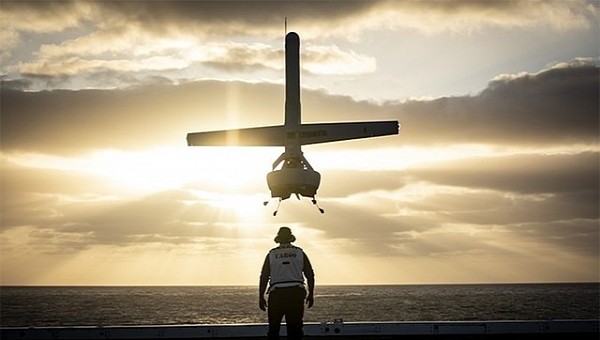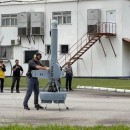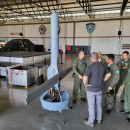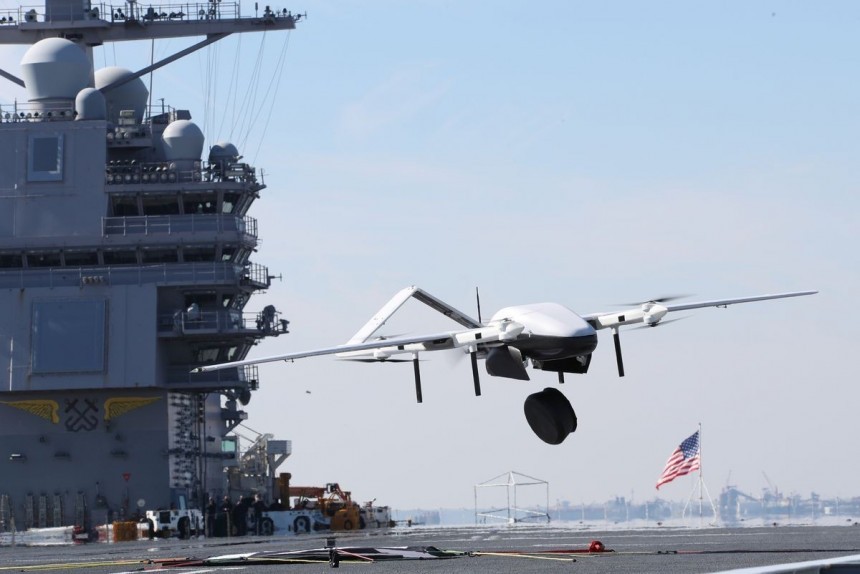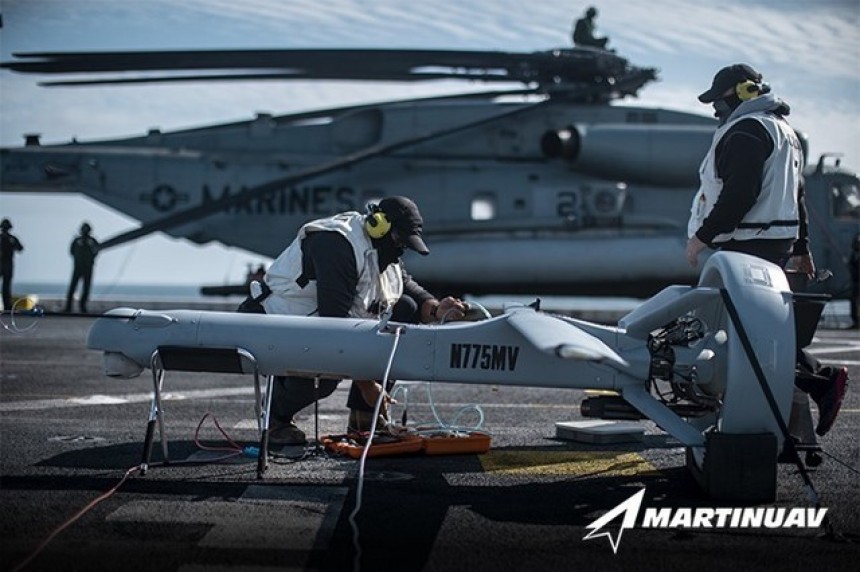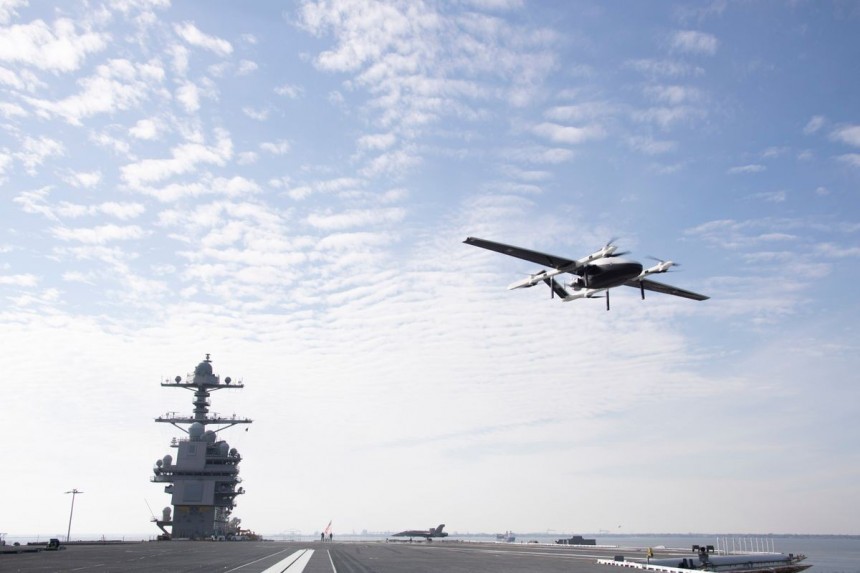The U.S. Navy takes one more step towards the age of the machines with a successful test of long-range shore-to-ship supplies delivery using “unmanned air systems.” Colloquially known as “drones” to the civilian public, these remotely operated flying aircraft are capable of carrying payloads of up to 50 lbs. (22.7 kg) over 200 nautical miles (230 statute miles, 370 kilometers).
The Naval Air Warfare Center Aircraft Division (NAWCAD, for short) “recently demonstrated multiple unmanned systems in a first-of-its-kind mission to move supplies to ships at sea.”
The two VTOLs involved in the testing are the V-BAT 128 from Martin UAV (a Shield AI division) and the Skyways V2.6 Cargo Aircraft. The vehicles employ impressive specs (compared to similar products destined for general public use) and have been selected for several reasons.
One criterion is the ability to transport cargo under 50 lbs. (22.7 kg). The number is not chosen randomly but represents the upper payload limit for 90% of the Navy’s logistics deliveries.
During an event at Naval Air Station Patuxent River in St. Inigoes, Maryland, the two drones flew to and from moving ships, hauling multiple “objects” (the wording is from the military’s terminology). These tests are the latest in a series that began in 2019 when the NAWCAD began experimenting with the Blue Water UAS prototype (also a Skyways product).
The most recent demonstration – the precise timeframe is unspecified – saw the two vehicles put to the trials of Navy’s test pilots and engineers to see if the aircraft meet military-grade requirements. Watch the video for a glimpse into the future of military logistics solutions.
The Martin UAV V-BAT “is the future of next-generation Unmanned Air Systems.” Dubbed by its manufacturer as the most tactical and logistically simple UAS in the world, this VTOL drone boasts unrivaled abilities. Its ducted fan propulsion enables it to take off and land in strong winds or on moving vessels.
Nine feet tall by 9.7 feet wide, this drone can fly for up to ten hours at a maximum altitude of 20,000 feet (6,100 meters). Alternatively, it can hover over a designated point for 45 minutes before refueling. The V-BAT takes less than fifteen seconds to transition from level flight to stationary mid-air floating.
Its maximum takeoff weight of just 125 lbs. (almost 57 kg, of which 25 lbs. is cargo – 11,3 kg) and its compact landing print of just 12x12 feet (3.7x3.7 meters) make it very suitable for naval operations.
According to Shield AI, “V-BAT is designed explicitly for runway and equipment-independent launch and recovery in austere environments with no external support. The aircraft can be transported in the bed of a truck and assembled by two personnel in under 20 minutes.”
The second remote-controlled drone that the U.S. Navy tested is the Skyways V2.6 Hybrid-Electric cargo aircraft. The details on the company’s website are austere. The bottom-line essential information is this: the UAV can reach zones 500 miles from the departure point with a payload of 25 lbs. (11.3 kg).
Apart from its space-saving folding-wing design, the drone (propelled by a hybrid electric powertrain) can be recharged mid-flight. However, the details about the VTOL’s performance are undisclosed.
Still, in May 2020, Skyways won the U.S. Navy contract with a drone with the following specifications: eight electric motors – for takeoff, hovering, and landing, and a gasoline engine for horizontal long-distance flight.
Skyways was granted the contract after their product delivered a payload on a moving ship without human intervention – that is, the flight operations were AI-managed. Allegedly, V2.6 was the only system capable of performing the whole process autonomously.
This gets a new meaning if we consider that all the competitors – 65 in total – were given the approximate coordinates of the ship. The drones had to search, detect, and identify the vessel in an eleven-mile-radius area before landing on it.
The two VTOLs involved in the testing are the V-BAT 128 from Martin UAV (a Shield AI division) and the Skyways V2.6 Cargo Aircraft. The vehicles employ impressive specs (compared to similar products destined for general public use) and have been selected for several reasons.
One criterion is the ability to transport cargo under 50 lbs. (22.7 kg). The number is not chosen randomly but represents the upper payload limit for 90% of the Navy’s logistics deliveries.
During an event at Naval Air Station Patuxent River in St. Inigoes, Maryland, the two drones flew to and from moving ships, hauling multiple “objects” (the wording is from the military’s terminology). These tests are the latest in a series that began in 2019 when the NAWCAD began experimenting with the Blue Water UAS prototype (also a Skyways product).
The Martin UAV V-BAT “is the future of next-generation Unmanned Air Systems.” Dubbed by its manufacturer as the most tactical and logistically simple UAS in the world, this VTOL drone boasts unrivaled abilities. Its ducted fan propulsion enables it to take off and land in strong winds or on moving vessels.
Nine feet tall by 9.7 feet wide, this drone can fly for up to ten hours at a maximum altitude of 20,000 feet (6,100 meters). Alternatively, it can hover over a designated point for 45 minutes before refueling. The V-BAT takes less than fifteen seconds to transition from level flight to stationary mid-air floating.
Its maximum takeoff weight of just 125 lbs. (almost 57 kg, of which 25 lbs. is cargo – 11,3 kg) and its compact landing print of just 12x12 feet (3.7x3.7 meters) make it very suitable for naval operations.
The second remote-controlled drone that the U.S. Navy tested is the Skyways V2.6 Hybrid-Electric cargo aircraft. The details on the company’s website are austere. The bottom-line essential information is this: the UAV can reach zones 500 miles from the departure point with a payload of 25 lbs. (11.3 kg).
Apart from its space-saving folding-wing design, the drone (propelled by a hybrid electric powertrain) can be recharged mid-flight. However, the details about the VTOL’s performance are undisclosed.
Still, in May 2020, Skyways won the U.S. Navy contract with a drone with the following specifications: eight electric motors – for takeoff, hovering, and landing, and a gasoline engine for horizontal long-distance flight.
This gets a new meaning if we consider that all the competitors – 65 in total – were given the approximate coordinates of the ship. The drones had to search, detect, and identify the vessel in an eleven-mile-radius area before landing on it.
